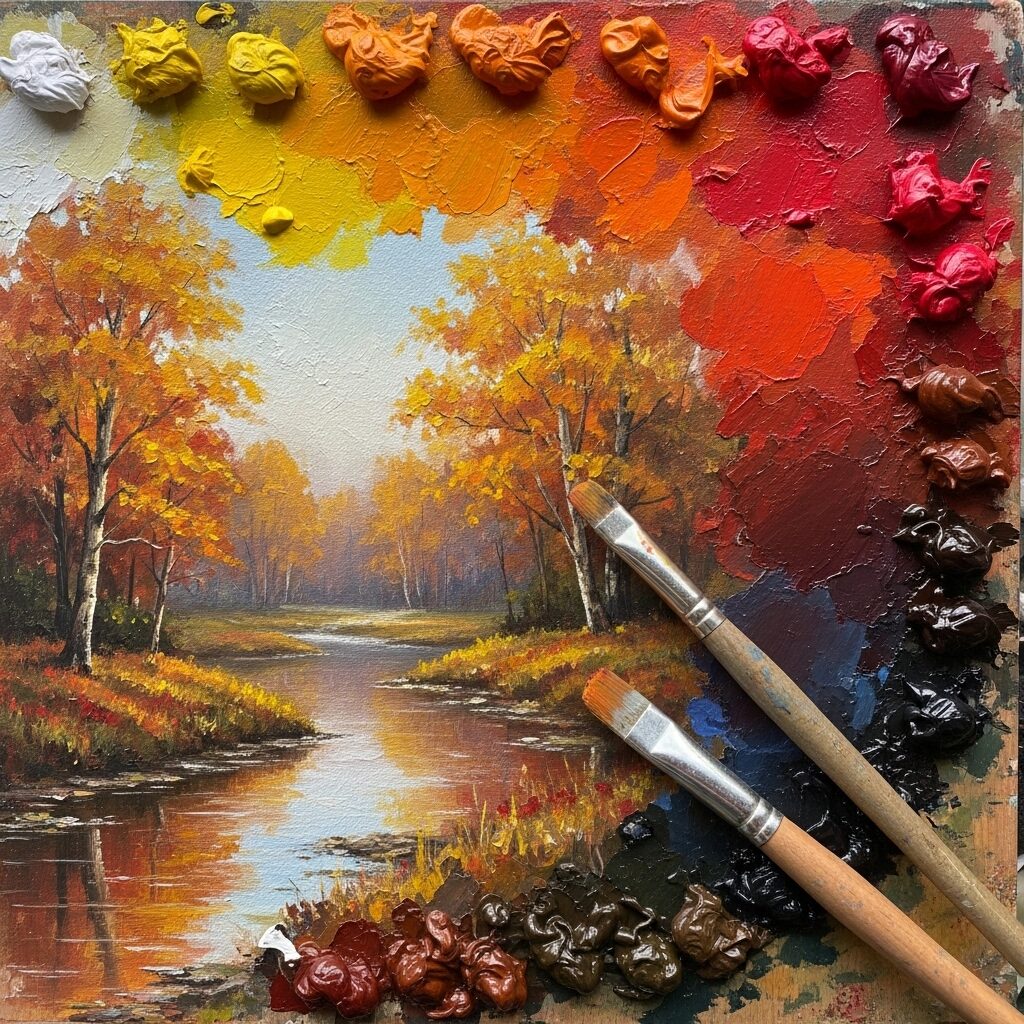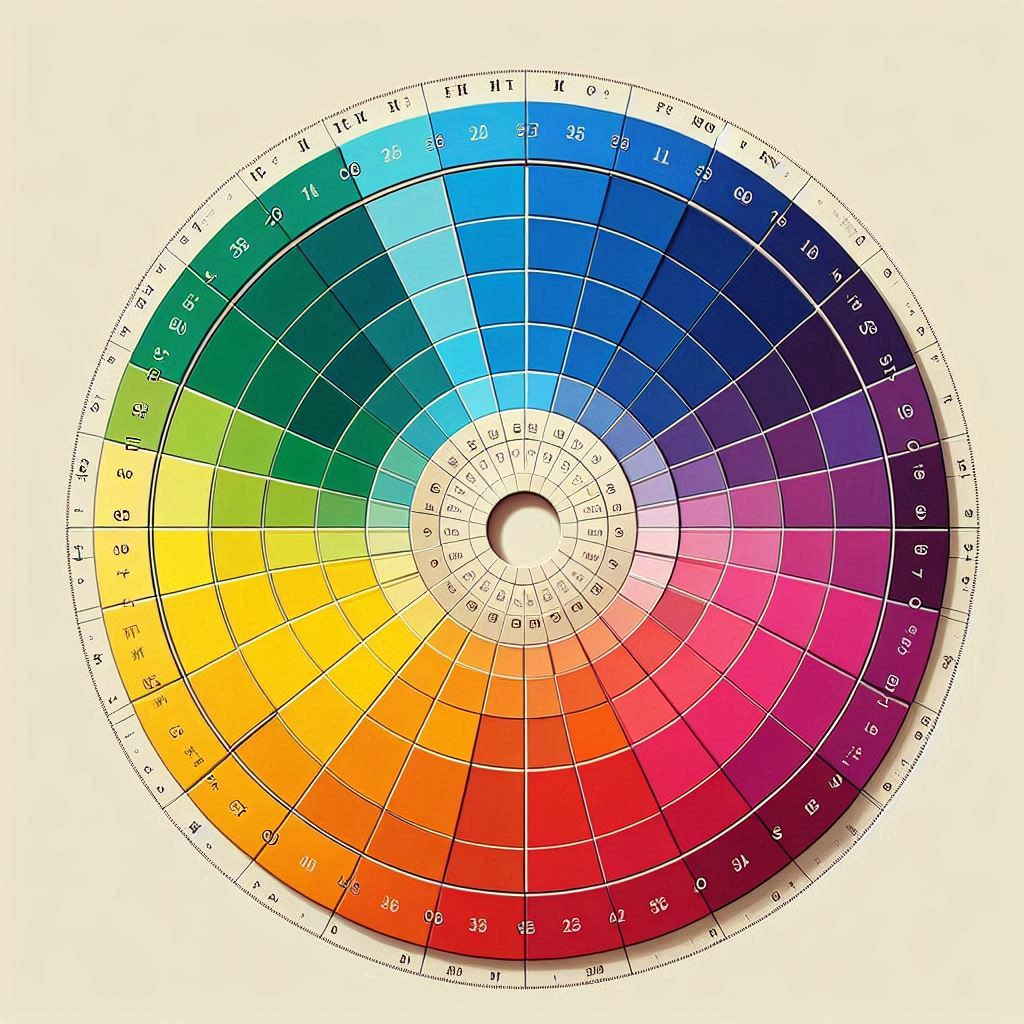Painting outdoors, or “plein air” as the French call it, offers artists an incredible opportunity to capture nature’s ever-changing beauty directly from life. Whether you’re a complete beginner or looking to expand your outdoor painting skills, mastering plein air art painting tips for different seasons will transform your artistic journey and help you create stunning landscapes throughout the year.
Key Points Summary
- Spring: Focus on fresh greens, variable weather protection, and capturing soft morning light
- Summer: Master heat management, early/late painting sessions, and intense shadow techniques
- Fall: Perfect autumn color mixing, wind protection strategies, and golden hour optimization
- Winter: Learn snow painting techniques, cold weather gear, and simplified compositions
- Equipment: Adapt your plein air setup for seasonal conditions and weather challenges
The magic of plein air painting lies in its immediacy and authenticity. Unlike studio work, outdoor painting forces you to work quickly, make decisive color choices, and truly observe how light and atmosphere change throughout the day and seasons. This comprehensive guide will equip you with essential techniques, equipment recommendations, and problem-solving strategies to help you paint confidently outdoors in any season.
What Makes Plein Air Painting Special?
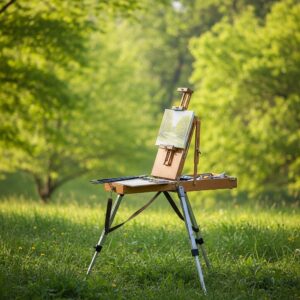
Plein air painting connects you directly with nature and teaches invaluable lessons about color theory and natural lighting that you simply cannot learn indoors. The French Impressionists like Claude Monet and Pierre-Auguste Renoir revolutionized art by taking their easels outdoors, capturing the fleeting effects of natural light and atmospheric conditions.
When you paint en plein air, you’re working with constantly changing conditions. The golden hour light that makes your landscape glow will shift within minutes. Clouds move, casting different shadows across your composition. This challenge forces you to develop keen observation skills and work with confidence and speed.
Essential Plein Air Art Painting Tips for Spring Success
Spring brings unique opportunities and challenges for outdoor painters. The season’s variable weather means you need to be prepared for anything from gentle sunshine to sudden showers.
Weather Variability Solutions
Spring weather changes quickly, so always check forecasts and pack accordingly. Bring a lightweight painting umbrella that can protect both you and your canvas from unexpected rain. Position your easel so you can quickly move to shelter if needed.
The soft, diffused light of spring mornings is perfect for capturing fresh greens and blooming flowers. Start painting early when the light is gentle and shadows are long. As the day progresses, you’ll notice how the light becomes harsher and colors appear more saturated.
Fresh Color Mixing Techniques
Spring greens can be tricky – they’re not the deep, rich greens of summer. Mix your spring greens using cadmium yellow with touches of viridian or ultramarine blue. Add a tiny amount of cadmium red to gray down overly bright greens and make them more natural.
For blooming flowers, use delicate mixtures. Cherry blossoms aren’t pure white – they have subtle pinks and yellows. Daffodils aren’t simply cadmium yellow – they have cooler shadows and warmer highlights.
Summer Outdoor Painting Mastery
Summer presents the biggest challenges for plein air painters: intense heat, harsh sunlight, and rapidly drying paints. However, with the right strategies, summer can produce some of your most vibrant and dramatic paintings.
Heat Management Techniques
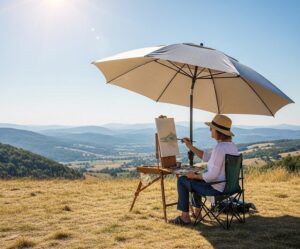
Start your painting sessions before 9 AM or after 5 PM when the light is more manageable and temperatures are cooler. The golden hour provides beautiful warm light without the harsh shadows of midday.
Always bring plenty of water – both for drinking and for your paints if you’re using watercolors. Keep your paint tubes in a cooler or insulated bag to prevent them from becoming too soft or even bursting in extreme heat.
Set up a large painting umbrella to create shade for both yourself and your canvas. Direct sunlight on your canvas creates glare that makes it impossible to see your colors accurately.
Intense Light Handling
Summer light creates strong contrasts between light and shadow. Don’t try to paint every detail you see – instead, focus on the major light and shadow patterns. Squint your eyes to simplify these patterns and avoid getting lost in small details.
Use a viewfinder to help compose your painting and isolate the most important elements. This simple tool, which you can make from cardboard, helps you focus on essential shapes and create depth in your paintings.
Fall Plein Air Excellence
Autumn offers painters the most spectacular color opportunities of the year. However, fall also brings shorter days, cooler temperatures, and often windy conditions that can challenge even experienced artists.
Autumn Color Capture
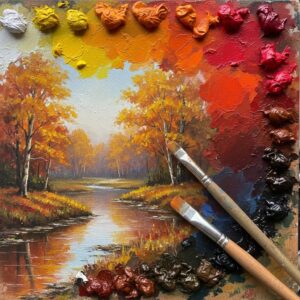
Don’t try to paint every single autumn leaf – instead, focus on the overall color relationships and patterns. Look for the warm oranges and reds in sunlight and the cooler purples and blues in shadows.
Mix your autumn colors carefully. Avoid using colors straight from the tube – they’ll look artificial. Instead, create complex mixtures using cadmium orange, burnt sienna, raw umber, and cadmium yellow for your warm colors. Add ultramarine blue and alizarin crimson for your cooler tones.
The key to successful autumn paintings is understanding color temperature. Warm colors (oranges, reds, yellows) appear to come forward, while cool colors (blues, purples) recede into the background.
Wind Management Strategies
Fall winds can turn your easel into a sail. Use a sturdy French easel or pochade box that sits lower to the ground. Many artists attach small weights or sandbags to their easel legs for extra stability.
Secure your canvas with clips designed for plein air painting. Keep extra clips handy in case the wind picks up unexpectedly. Consider using canvas panels instead of stretched canvases – they’re less likely to catch the wind.
Winter Painting Adaptations

Winter plein air painting might seem impossible, but it offers unique opportunities to create stunning, simplified compositions with beautiful color harmonies.
Cold Weather Strategies
Dress in layers and wear fingerless gloves that allow you to hold brushes while keeping your hands warm. Bring a thermos of hot coffee or tea to warm up during painting breaks.
Cold temperatures affect your paints differently. Oil paints become stiffer and harder to mix, while watercolors may freeze. Keep your paint tubes inside your jacket to maintain workable consistency.
Snow Painting Techniques
Snow isn’t white – it reflects the colors around it. In shadows, snow appears blue or purple because it reflects the blue sky. In sunlight, snow takes on warm yellows and pinks from the sun’s light.
Use a limited palette for winter scenes. A simple palette of ultramarine blue, burnt umber, and cadmium yellow can create beautiful, harmonious winter paintings.
Year-Round Equipment Essentials
Your plein air setup needs to adapt to different seasonal conditions. Here’s a seasonal equipment guide:
| Season | Essential Equipment | Special Considerations |
|---|---|---|
| Spring | Lightweight easel, rain protection, fresh color palette | Variable weather gear |
| Summer | Shade umbrella, cooling accessories, extra water | Heat management tools |
| Fall | Wind clips, warm layers, autumn colors | Stability enhancements |
| Winter | Insulated supplies, warm clothing, simplified kit | Cold weather adaptations |
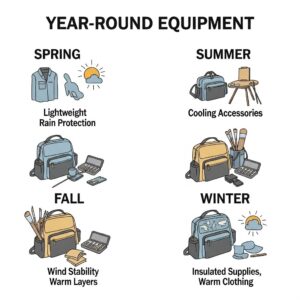
Consider investing in a quality pochade box for smaller studies and a French easel for larger works. Both should be lightweight yet stable enough to handle outdoor conditions.
Advanced Techniques for All Seasons
Capturing Changing Light
Light changes constantly outdoors. Professional plein air painters often work on multiple small studies rather than one large painting. This approach allows you to capture specific lighting conditions without trying to chase the changing light across one canvas.
Start each painting session by doing quick value studies to establish your major light and dark patterns before the light changes.
Simplification Strategies
The biggest mistake beginner plein air painters make is trying to paint everything they see. Instead, focus on the essential elements that make your scene compelling. Ask yourself: “What attracted me to this scene?” Then emphasize those elements and simplify or eliminate distracting details.
“The secret of getting ahead is getting started. The secret of getting started is breaking your complex overwhelming tasks into small manageable tasks, and starting on the first one.”
Mark Twain
This principle applies perfectly to plein air painting – break complex scenes into simple, manageable shapes and color relationships.
Recommended YouTube Tutorial
Common Plein Air Challenges and Solutions
Every outdoor painter faces similar challenges. Here are solutions to the most common problems:
Problem: Paint drying too fast in hot weather
Solution: Use a medium or add a small amount of clove oil to slow drying time
Problem: Colors looking muddy
Solution: Clean your brushes more frequently and use separate brushes for warm and cool colors
Problem: Difficulty seeing canvas in bright sunlight
Solution: Position your easel so the canvas is in shade while you maintain good light on your subject
FAQ: Common Plein Air Questions
What is plein air painting? Plein air painting is the practice of painting landscapes outdoors, directly from nature, rather than from photographs or in a studio. The term comes from the French phrase “en plein air,” meaning “in the open air.”
How do you pronounce plein air? Plein air is pronounced “plen-AIR” with emphasis on the second syllable. It rhymes with “then care.”
What supplies do I need for plein air painting? Essential plein air supplies include a portable easel or pochade box, canvas panels, basic paint colors, brushes, palette knife, paper towels, and a container for medium or water. Don’t forget sun protection and weather-appropriate clothing.
Is plein air painting difficult? Plein air painting has unique challenges like changing light and weather conditions, but it’s not necessarily more difficult than studio painting. The key is starting with simple subjects and gradually building your skills and confidence outdoors.
How long does a plein air painting take? Most plein air paintings are completed in 1-3 hours to capture consistent lighting conditions. Some artists create quick 30-minute studies, while others may work on larger pieces over multiple sessions.
What’s the difference between plein air and studio painting? Plein air painting is done outdoors from direct observation, while studio painting is typically done indoors from references like photographs or memory. Plein air work tends to have more immediate, fresh brushwork and accurate color relationships due to direct observation of natural light.
Mastering plein air art painting tips for all seasons opens up endless possibilities for artistic growth and creative expression. Each season offers unique lessons in color, light, and composition that will improve not only your outdoor painting but your studio work as well. Remember, the goal isn’t perfection – it’s capturing the essence of a moment in nature and growing as an artist through direct observation and practice.
Additional Resources
- PleinAir Magazine – Leading publication for outdoor painting techniques and inspiration
- Outdoor Painter Magazine – Comprehensive resource for landscape and plein air painting
- James Gurney’s Color and Light Book – Essential guide to understanding natural light and color
- Virtual Art Academy – Online courses specifically for plein air and landscape painting
- Jackson’s Art Blog – Equipment reviews and technique articles for outdoor painters
- The Artist’s Magazine – General art instruction including plein air techniques and tips

